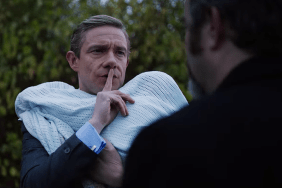Now available on DVD

Asylum
Peter Cushing as Smith
Britt Ekland as Lucy
Herbert Lom as Byron
Patrick Magee as Dr. Rutherford
Barry Morse as Bruno
Barbara Parkins as Bonnie
Robert Powell as Dr. Martin
Charlotte Rampling as Barbara
Directed by Roy Ward Baker
And Now the Screaming Starts!
Peter Cushing as Dr. Pope
Herbert Lom as Henry Fengriffen
Patrick Magee as Dr. Whittle
Stephanie Beacham as Catherine Fengriffen
Ian Ogilvy as Charles Fengriffen
Geoffrey Whitehead as Silas
Guy Rolfe as Maitland
Rosalie Crutchley as Mrs. Luke
Directed by Roy Ward Baker
The Beast Must Die
Calvin Lockhart as Tom Newcliffe
Peter Cushing as Dr. Christopher Lundgren
Marlene Clark as Caroline Newcliffe
Anton Diffring as Pavel
Charles Gray as Arthur Bennington
Ciaran Madden as Davina Gilmore
Tom Chadbon as Paul Foote
Michael Gambon as Jan Jarmokowski
Directed by Paul Annett
Review:
While Hammer Films dominated the British horror scene from the late ’50s through the mid-’70s, it was their closest competitors Amicus Productions â famous for their anthology pictures such as “Tales from the Crypt” and “The House That Dripped Blood” â that always held more appeal to me as a young fan. Maybe it was because as entertaining and rip-roaring as the Hammer pictures often were, I always thought their takes on the classic monsters couldn’t help but come in second to the Universal versions. Or maybe it was just that their brand of period-set Gothic horror never seemed genuinely scary to me. Amicus’ films, on the other hand, were typically set in the present day, featured much more psychologically twisted tales than Hammer, and seemed to go for the throat more than any horror movies I had been allowed to see up to that point.
Dark Sky Films has just released a box set of three Amicus titles â “And Now The Screaming Starts!,” “Asylum,” and “The Beast Must Die” â that the company had previously issued separately and it’s a well-rounded collection that will appeal to both old fans and new devotees of “the studio that dripped blood.”
1972’s “And Now The Screaming Starts!” took Amicus away from its familiar formulas. For one, it was a period piece (set in 1795 England), and secondly it was a full-length story rather than an anthology. But while “And Now The Screaming Starts!” is generally regarded as one of the weaker films in the Amicus catalog, its poor reputation confounds me as I think this deserves some belated acclaim (or at least some credit) for presenting as dark and despairing a storyline as it does.
Based on David Case’s novel Fengriffen, “And Now The Screaming Starts!” begins as Charles Fengriffen (Ian Ogilvy) is bringing his virgin bride Catherine (Stephanie Beacham) to live within his ancestral family home. But on their wedding night, the couple’s new happiness is shattered when Catherine is raped by a ghost residing within the gothic mansion. Unable to get anyone to believe her, Catherine becomes plagued by visions of a woodsman with empty, bloody eye sockets and one arm ending in a bloody stump (a wonderfully grisly make-up job that holds up today). In the meantime, anyone in the cast who starts to lend a hand to Catherine is slain by the woodsman’s disembodied hand.
Things go from bad to worse when it’s discovered that Catherine is pregnant and she is certain that the baby was conceived during her assault (even though we’ve seen Catherine and Charles together romantically since their ill-fated wedding night, her reaction when told of the news of her pregnancy almost comes across as an implication that she never consummated her marriage with Charles). This is strong material (carried off well by Beacham in an underrated performance) in that Catherine is forced to reluctantly bear the child of a creature that raped her and things only get bleaker as events continue and the depraved actions of Charles’ late grandfather, Henry Fengriffen (Herbert Lom), are revealed. By the end of the film, some may be shocked at how bitter a note this is willing to end on. Director Roy Ward Baker had already done several well-received films for Hammer and his contributions to Amicus were similarly excellent. Besides Lom, Amicus and Hammer acting stalwarts Peter Cushing and Patrick Magee also appear here, bringing their typically memorable presences to their respective supporting roles.
On Dark Sky’s DVD, Ian Ogilvy reminisces about his experiences on the film on a commentary track moderated by Darren Gross, with Baker and Beacham speaking together on a separate track. Three Amicus trailers (for each of the films included in this set) are also included.
The anthology picture “Asylum” (1972) is an example of what Amicus was best known for and this is a strong contender for Amicus’ best crack at the multi-story format. With four tales from frequent Amicus contributor Robert Bloch â who penned “Asylum’s screenplay, adapting his own stories to the screen â and arguably the best wraparound story to ever link an anthology, Asylum is a film that gets it absolutely right. Bloch’s stories are all solid and even the ones that may be on the obvious side (such as “Lucy Comes To Stay” with Charlotte Rampling as a mentally unstable woman contending with her vivacious best friend Lucy, played by Britt Ekland) benefit from strong acting and the assured direction of Roy Ward Baker.
Asylum’s inspired wraparound story involves the eager, somewhat arrogant, Dr. Martin (Robert Powell) who has come to the Dunmoor Asylum for the criminally insane for the purposes of interviewing for a job. But upon his arrival, he is told that the asylum director, Dr. Starr, has experienced a complete mental breakdown and is now living with the craziest of the crazies on the top floor, high security wing of the asylum. Dr. Starr has adopted a completely new personality with its own history and mannerisms. If Dr. Martin can interview the patients living on this floor and identify which one is Starr, then the job will be his.
This is a perfect set-up for an anthology, giving every tale an added level of interest. It also ensures that each return to the wraparound will add to a larger story that’s involving in its own right. And when the final pay-off does come, it’s a much more satisfying conclusion than the wraparound device the typical anthology offered (a device Amicus itself made famous) wherein a group of characters that have listened to each other’s stories while sharing a train ride or exploring a set of caves or whatever all discover to their horror that they’re either already dead (!) or in Hell itself (!!). Bloch’s “Asylum” script is resourceful in sidestepping any such hokiness.
Dark Sky’s release of “Asylum” features a commentary by Roy Ward Baker and cameraman Neil Binney as well as theatrical trailers and a well-produced and bluntly honest 20 min. doc on Amicus itself â “Inside the Fear Factory” â centered around interviews with key Amicus figures such as the company’s co-founder, producer Max J. Rosenberg and directors Freddie Francis and Roy Ward Baker. Since this doc’s making, both Rosenberg and Francis have sadly passed away.
Finally, 1973’s “The Beast Must Die” is one of Amicus’ most fondly remembered titles, placing its werewolf tale in a thoroughly modern context. Calvin Lockhart (Cotton Comes to Harlem) plays wealthy big game hunter Tom Newcliffe who has brought a disparate group of guests (portrayed by the likes of Peter Cushing, Charles Gray, and Michael Gambon) to his private island. Newcliffe’s ulterior motive in all this is that he believes that one of his guests is secretly a werewolf and he intends to flush out this beast in their midst, and prove his hunting prowess by slaying the creature. So this emerges as a lycanthropic version of “The Most Dangerous Game” mixed with Agatha Christie’s “Ten Little Indians.” And with Lockhart’s character being by far the coolest cat in the room (when one character protests to Newcliffe “I don’t have to take that kind of talk from you!”, Newcliffe’s curt reply is “You just did.”) and its horn-heavy musical score, “The Beast Must Die” also bears inclusion in the blaxploitation fad of the early ’70s (indeed, the alternate video title for this was “Black Werewolf”).
“The Beast Must Die” is most famous for its unique “Werewolf Break” (a last minute editing room addition from producer and Amicus co-founder Milton Subotsky) in which the film stops for thirty seconds before the climax so the audience can guess which of the characters is the furry fiend (as the opening narration intones: “This is a detective story in which YOU are the detective.”). And all gimmicks aside, the film proves to be satisfyingly tricky in revealing the identity of its werewolf. And in typically downbeat Amicus fashion, Newcliffe comes to regret his single-minded pursuit of the hunt.
The one unfortunate weakness of “The Beast Must Die” is that such a great story is hampered by a low budget and mediocre effects. Long before John Landis and Rick Baker made the notion of a werewolf that is more of a pure wolf, walking on four legs rather than two, one of “An American Werewolf in London’s most memorable visuals, “The Beast Must Die” had the same idea but wasn’t able to execute it nearly as well. Instead, this film’s “werewolf” is very obviously a dog. Director Paul Arnett does his best to disguise this fact but even as a unsophisticated kid watching this on TV in the ’70s, I wasn’t fooled. And Newcliffe’s high-tech arsenal could’ve used some juicing up as well.
With Amicus currently re-launching itself as an active production company, I hope someone there has the notion to remake “The Beast Must Die” (sans the Werewolf Break) as it’s one of the few movies from my childhood that I would actually love to see retold with a bigger budget and with FX that could do it justice. And if they’re not thinking about it yet, please let me be the first to suggest it!
Dark Sky’s DVD of “The Beast Must Die” features full-length commentary by director Arnett, a fourteen minute featurette “Directing the Beast”, a tribute to Peter Cushing by Arnett, trailers and a still gallery.
Amicus’ films never received the same sort of hoopla that Hammer’s pictures did but for this fan, their impact was more profound. And I think their often-nihilistic tone allows them play as very modern even today. This box set will be welcome to any fan of the company’s catalog and also serve as a perfect introduction to viewers looking to see what “Hammer’s little brother” was capable of.









